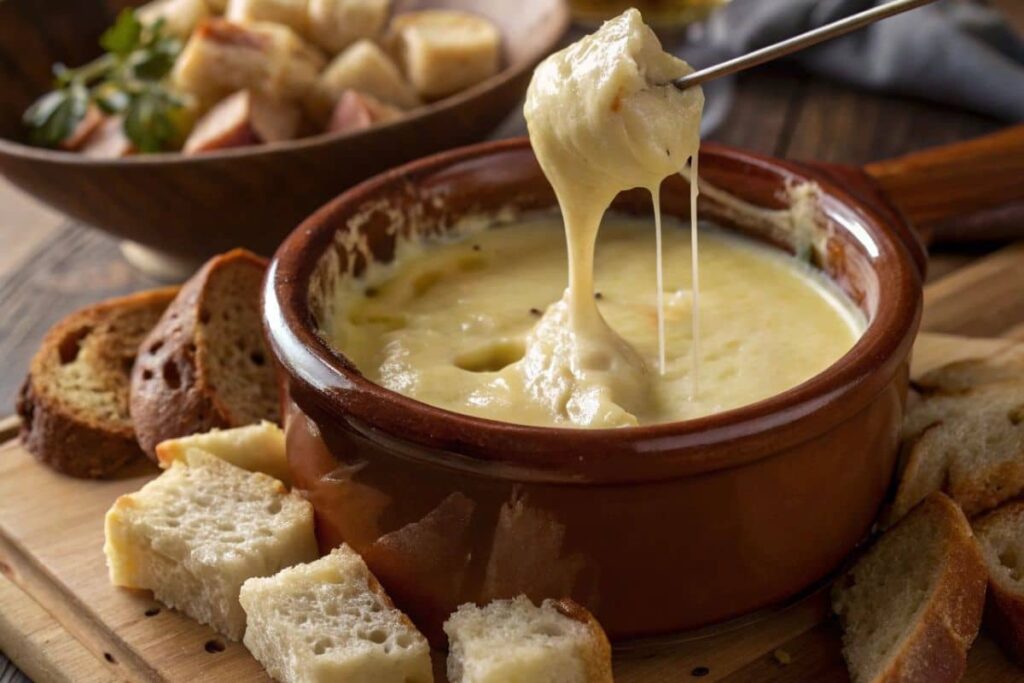What Does Gruyere Cheese Taste Like? If you’ve ever wondered about the flavor of this delightful cheese, you’re in for a treat! This Swiss cheese is a star in the culinary world, celebrated for its rich flavors and versatile uses. In this article, we’ll dive deep into everything you need to know about Gruyere—its taste, texture, cooking potential, and so much more. Let’s get cheesy!
Table of Contents

Introduction to Gruyere Cheese
The Origin and History of Gruyere Cheese
Gruyere cheese, pronounced “groo-YAIR,” originates from Switzerland, specifically the small town of Gruyères. Picture lush green meadows, alpine cows, and rolling hills—it’s no wonder this place produces such a delightful cheese! Gruyere has been around since the 12th century, making it a true testament to Swiss cheesemaking tradition.
In 2001, Gruyere received a prestigious Protected Designation of Origin (PDO) status. This means that for a cheese to be called “Gruyere,” it must be made in specific regions of Switzerland using traditional methods. Fancy, right?
“Gruyere cheese isn’t just food; it’s a piece of history you can taste.”
How Gruyere Cheese Is Made: From Milk to Wheel
The process of making Gruyere is both art and science. It starts with fresh, unpasteurized cow’s milk. This milk is gently heated and mixed with rennet to form curds. The curds are then cut, drained, and pressed into molds to form wheels. After that, the cheese wheels are aged in caves for anywhere from five months to two years. The longer it ages, the more intense and complex the flavors become. Cool, huh?
The Unique Taste Profile of Gruyere Cheese
What Does Gruyere Cheese Taste Like? Nutty and Earthy Notes
When you take your first bite of Gruyere, you’re greeted with a nutty, earthy flavor that feels both comforting and elegant. It’s like the cozy warmth of a campfire but in cheese form. These flavors are subtle yet satisfying, making Gruyere a crowd-pleaser for both cheese newbies and connoisseurs.
The Sweet Undertones: Hints of Caramelized Milk
As you savor Gruyere, you might notice a hint of sweetness—think caramelized milk or lightly toasted sugar. This sweetness is what sets Gruyere apart from other cheeses. It adds depth and makes every bite a delightful journey for your taste buds.
Aging and Its Impact on Gruyere’s Flavor
Did you know that Gruyere’s flavor changes as it ages? Young Gruyere (aged 5–6 months) is mild, creamy, and slightly sweet. On the other hand, aged Gruyere (12 months or more) develops bold, nutty, and slightly tangy notes. It’s like the cheese version of growing up—it just gets better with time!
Comparing Gruyere to Other Popular Cheeses
How does Gruyere stack up against other cheeses? If you’ve tried Emmental, you’ll find similarities in the nuttiness, but Gruyere has a smoother, more refined taste. Compared to Cheddar, Gruyere is less sharp and more buttery. And if you’re thinking of Mozzarella, forget it—Gruyere is in a flavor league of its own!
Texture: What to Expect from Gruyere Cheese
The Creamy Yet Firm Texture Explained
Gruyere cheese has a fascinating texture. It’s firm enough to slice neatly, yet creamy enough to melt beautifully. Imagine biting into a block of smooth, slightly elastic cheese that practically melts in your mouth. It’s the best of both worlds!
How Texture Changes with Aging
Just like its flavor, Gruyere’s texture evolves over time. Younger Gruyere is pliable and soft, making it perfect for sandwiches or cheese boards. Aged Gruyere, however, becomes crumbly and dense—ideal for grating over pasta or salads. It’s like the cheese grows up alongside its flavor!
Popular Dishes Featuring Gruyere Cheese
Gruyere in Fondue: A Swiss Classic
What Does Gruyere Cheese Taste Like in Fondue? Gruyere cheese is the star of the show in traditional Swiss fondue. Imagine sitting around a bubbling pot of melted cheese, dipping chunks of crusty bread into the gooey goodness—pure magic, right? Gruyere’s perfect melting qualities and nutty-sweet flavor make it a must-have ingredient in this communal dish. The cheese is often combined with Emmental and a splash of white wine, creating a smooth and flavorful blend that’s hard to resist.
Here’s a tip: Add a pinch of nutmeg or garlic to the fondue for an extra kick of flavor. And don’t forget the rule of fondue—if you drop your bread in the pot, you owe the group a round of jokes or a fun dare! 🫕🫕
Gruyere in Croque Monsieur and Croque Madame

What Does Gruyere Cheese Taste Like in Croque Monsieur and Croque Madame? What’s better than a grilled cheese sandwich? A French upgrade! Gruyere is the key ingredient in Croque Monsieur and its fancier sibling, Croque Madame. These decadent sandwiches combine ham, Gruyere, and béchamel sauce, all grilled to perfection. The Croque Madame adds a fried egg on top, taking indulgence to the next level.
What does Gruyere cheese taste like in these sandwiches? Its creamy, melt-in-your-mouth texture ensures that every bite is as luxurious as it sounds. Serve it with a side of mixed greens for a balanced yet indulgent meal.
Gruyere in Quiches
Quiche is one of the most versatile dishes you can make, and Gruyere cheese is a favorite ingredient for adding richness and depth. Whether it’s a classic quiche Lorraine with bacon and onions or a veggie-packed version with spinach and mushrooms, Gruyere takes the dish to another level.
Gruyere’s creamy texture ensures it melts seamlessly into the egg mixture, while its nutty flavor enhances every ingredient in the quiche. Pro tip: Sprinkle a little extra Gruyere on top before baking for a golden, bubbly finish.
Gruyere in Gratin Dishes
Gruyere is the go-to cheese for gratin dishes, thanks to its perfect melting properties and ability to create a crispy, golden crust. Think potato gratin, cauliflower gratin, or even mac and cheese—Gruyere adds a sophisticated touch to these comfort food classics.
For a show-stopping side dish, try layering thinly sliced potatoes with cream, garlic, and Gruyere, then bake until bubbling and golden. It’s the ultimate crowd-pleaser at any dinner table!
Gruyere in Savory Tarts and Pies
What Does Gruyere Cheese Taste Like in Savory Bakes? From savory tarts to rustic pies, Gruyere cheese is a fantastic addition to baked dishes. It pairs beautifully with ingredients like caramelized onions, leeks, or tomatoes, creating a balance of flavors that’s both rich and refreshing. Add it to a puff pastry base for an easy yet impressive appetizer or brunch dish.
What does Gruyere cheese taste like in these recipes? Its mild sweetness and creamy texture shine through, ensuring it complements, rather than overpowers, other ingredients. This makes Gruyere a versatile choice for all kinds of savory bakes, elevating the flavor profile of each dish with its nutty and slightly sweet notes.
Gruyere in Pasta Dishes
When it comes to pasta, Gruyere is the ultimate game-changer. Its smooth melting quality makes it perfect for creamy sauces and baked pasta dishes. Imagine a rich Gruyere Alfredo sauce poured over fettuccine, or a cheesy Gruyere topping on baked ziti. Hungry yet?
For a gourmet twist, try making a Gruyere mac and cheese. Combine the cheese with a hint of Dijon mustard and a sprinkle of breadcrumbs for a dish that’s comforting yet sophisticated. It’s comfort food, upgraded!
Gruyere on Cheese Boards
Last but not least, don’t underestimate Gruyere’s potential as part of a cheese board. Its nutty and slightly sweet flavor pairs beautifully with fruits like apples, pears, and grapes, as well as nuts and honey. Add a crusty baguette or crackers, and you’ve got a party hit.
“Gruyere isn’t just an ingredient—it’s a passport to delicious, versatile cooking!”
Gruyere in French Onion Soup

French onion soup is a dish that warms the soul, and Gruyere cheese is its crowning glory. This hearty soup is made with caramelized onions, beef broth, and a touch of white wine, but it’s the Gruyere that steals the show. The cheese is layered over a slice of toasted baguette, then broiled until golden and bubbly, forming a rich, savory crust that perfectly complements the sweet onions beneath.
The next time you make French onion soup, go for a high-quality Gruyere—its nutty, slightly sweet flavor elevates the dish to restaurant-level deliciousness. Pair it with a glass of red wine, and you’re in for a treat!
Frequently Asked Questions About Gruyere Cheese
Can Gruyere Cheese Be Eaten Raw?
Absolutely! Gruyere is delicious straight from the block. Pair it with crackers, fruits, or even a slice of crusty bread for a simple yet satisfying snack.
What Pairs Best with Gruyere Cheese?
Gruyere loves to mingle with wines like Chardonnay or Pinot Noir. It also pairs well with fruits like apples and grapes, as well as nuts like almonds and walnuts. Basically, it’s the life of the cheese party!
Is Gruyere Cheese Lactose-Free?
Good news for the lactose-sensitive folks—Gruyere is naturally low in lactose! As it ages, the lactose content decreases even further, making it easier to digest.
| Nutrient | Amount |
|---|---|
| Calories | 117 |
| Protein | 8g |
| Fat | 9g |
| Calcium | 200mg |
| Sodium | 200mg |
Common Problems and Solutions When Using Gruyere
Why Does Gruyere Sometimes Not Melt Properly?
What Does Gruyere Cheese Taste Like When Melted? Have you ever tried melting Gruyere, only to find it clumping instead of turning into that silky goodness? This can happen if the cheese is too cold or if the heat is too high. Gruyere loves gentle care—let it sit at room temperature for 15–20 minutes before melting and always use low to medium heat.
What does Gruyere cheese taste like when melted? Its nutty and slightly sweet flavors become even more pronounced, creating a rich and creamy texture that’s perfect for fondue or sauces. Another tip? Add a splash of acid, like lemon juice or white wine. This helps break down the proteins, ensuring a smooth, luscious consistency. Fondue fans, this trick is a game-changer!
How to Store Gruyere Cheese to Keep It Fresh
Storing cheese can feel like a science experiment, but it doesn’t have to be complicated. Wrap your Gruyere in wax paper or parchment paper first, then place it in a resealable plastic bag. The wax paper lets the cheese breathe while the bag prevents it from drying out.
Avoid plastic wrap directly on the cheese—it traps moisture, which can lead to mold. And always store Gruyere in the fridge, ideally in the vegetable drawer where humidity levels are just right.
What to Do If Gruyere Has Mold Spots
Don’t panic if you spot a little mold on your Gruyere. Simply cut off the affected area (at least 1 inch around and below the mold) and enjoy the rest. Hard cheeses like Gruyere are resilient and safe to eat after trimming. It’s like giving your cheese a quick haircut!
Nutritional Benefits of Gruyere Cheese
Calories and Macronutrient Breakdown
Gruyere cheese is a nutritional powerhouse. Here’s a quick breakdown of what you’re getting in every creamy bite:
| Nutrient | Amount |
|---|---|
| Calories | 117 |
| Protein | 8g |
| Fat | 9g |
| Calcium | 20% of Daily Value |
| Vitamin A | 6% of Daily Value |
Vitamins and Minerals in Gruyere Cheese
Gruyere is packed with essential nutrients. It’s rich in calcium, which keeps your bones strong, and contains phosphorus, a key player in energy production. Plus, it has a decent dose of vitamin A for healthy skin and eyes. Who knew indulging in cheese could be so good for you?
Is Gruyere Cheese a Healthy Choice?
While Gruyere is undeniably delicious, it’s also calorie-dense and high in fat. Enjoy it in moderation to keep your diet balanced. Pairing it with fresh fruits or whole-grain crackers is a great way to enjoy its flavor while staying mindful of portion sizes.
Alternatives to Gruyere Cheese: What to Use Instead
Cheeses That Mimic Gruyere’s Flavor
Can’t find Gruyere at your local store? No worries—there are some great substitutes. Comté and Emmental are both excellent alternatives, offering similar nutty and sweet flavors. These cheeses are also Swiss-made, so they share a lot in common with Gruyere.
Cheeses That Melt Like Gruyere
If you’re looking for a cheese that melts just as beautifully, consider Fontina or Havarti. Both are creamy and gooey when heated, making them perfect for dishes like fondue or French onion soup.
“Gruyere may be the star, but its understudies—Comté, Emmental, and Fontina—are equally impressive performers.”
Buying and Storing Gruyere Cheese: Expert Tips
How to Choose the Best Gruyere Cheese
When shopping for Gruyere, look for a firm, pale-yellow cheese with a slightly waxy rind. It should have a rich aroma and no cracks or dryness. Aged Gruyere might have small crystal-like spots—these are amino acid clusters and a sign of high quality. Fancy, right?
Where to Buy Authentic Gruyere Cheese
You’ll find authentic Gruyere at specialty cheese shops, gourmet grocery stores, or online retailers. Look for the PDO label to ensure you’re getting the real deal. Pro tip: If you’re near a Swiss or European market, they often carry Gruyere imported directly from Switzerland!
Proper Storage Techniques for Gruyere Cheese
Store Gruyere in the fridge, ideally in the vegetable drawer, where it’s cool and slightly humid. Use wax or parchment paper for wrapping, then place it in an airtight container. This method keeps your cheese fresh and flavorful for weeks.
Fun Facts About Gruyere Cheese
Gruyere’s Role in Swiss Culinary Heritage
Did you know Gruyere is one of Switzerland’s most iconic cheeses? It’s a key ingredient in Swiss fondue, alongside Emmental. Plus, it’s a staple in many traditional Swiss recipes, from rösti to tartiflette. Talk about a cheese with a legacy!
Awards and Recognitions for Gruyere Cheese
Gruyere has won multiple “Best Cheese” awards at international competitions. Its complex flavor and creamy texture make it a favorite among judges and foodies alike. It’s basically the Oscar winner of the cheese world!
Conclusion: Savoring the Taste of Gruyere Cheese
So, what does Gruyere cheese taste like? It’s a perfect blend of nutty, sweet, and savory flavors with a creamy yet firm texture. Whether you’re melting it into fondue, grating it over pasta, or enjoying it raw, Gruyere is a cheese that never disappoints. Give it a try, and let your taste buds embark on a Swiss adventure.
Now that you know all about Gruyere cheese, why not explore more cheesy delights? If you’re looking for alternatives, check out our guide on Gruyere cheese substitutes for a similar flavor profile. Curious about how Gruyere compares to other cheeses? Learn about the rich history and taste of Gouda cheese or dive into the bold and tangy world of blue cheese. And of course, don’t forget to revisit everything you’ve learned about Gruyere cheese itself—it’s a classic for a reason!

Gruyere Cheese Insights
Ingredients
Gruyere Cheese Overview
- 1 block Gruyere Cheese Ensure it is a high-quality, PDO certified cheese.
Instructions
Cheese Preparation
- Taste and enjoy the cheese raw as a snack with fruits and crackers.
- Use Gruyere in various dishes like fondue, quiches, and pasta for its rich flavor.
- Store Gruyere properly by wrapping in wax paper, then placing it in an airtight container.
Notes

Gruyere Cheese Overview
Ingredients
Main Ingredients
- 1 block Gruyere Cheese Ensure it is a high-quality, PDO certified cheese.
Instructions
Cheese Preparation
- Taste and enjoy the cheese raw as a snack with fruits and crackers.
- Use Gruyere in various dishes like fondue, quiches, and pasta for its rich flavor.
- Store Gruyere properly by wrapping in wax paper, then placing it in an airtight container.
Notes

Gruyere Cheese
Ingredients
Main Ingredients
- 1 block Gruyere Cheese Ensure it is a high-quality, PDO certified cheese.
Instructions
Cheese Preparation
- Taste and enjoy the cheese raw as a snack with fruits and crackers.
- Use Gruyere in various dishes like fondue, quiches, and pasta for its rich flavor.
- Store Gruyere properly by wrapping in wax paper, then placing it in an airtight container.





